A Trip through the Universe
at the Speed of Light
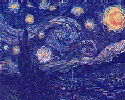

| Gene Smith's Astronomy Tutorial A Trip through the Universe at the Speed of Light |  |

 | Imagine taking a trip at the speed of light. The "ultimate speed limit" according to Einstein's Theory of Special Relativity; c = 186,000 miles/sec = 300,000 km/s = 3 x 10 10 cm/s (= 1 light-year/year). The effects of Special Relativity will have a profound effect upon space travel. Because mass increases as one's velocity approaches c, travel near the speed of light will be very expensive and will require spacecraft designs far different from those imagined on Sci-Fi TV programs. A phenomenon called time dilation, will cause space explorers traveling near the speed of light to age more slowly than their compatriots left behind on earth. For now we will ignore the details and set off on a journey to explore the Universe. |
For an idea of how long exploring the Universe would take at your favorite speed try this link at the University of Maryland; but remember to follow the speed limit.
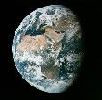 |
Earth
from space- taken by the Apollo 11 astronauts. Visible through the clouds
are the continents of Africa and Europe.
The Moon - 1.5 light seconds from the Earth. Current evidence suggests that the moon may have been blasted away from the earth about 4.5 billion years ago when a Mars-sized "planetesimal" collided with the newly formed Earth. More info at Bill Arnett's "The Nine Planets". |
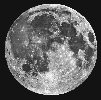 |
| Venus - About 2 minutes away when it is closest, would take almost 15 minutes when it is on the other side of the sun. Venus was thought originally to be our "sister planet"; visible as the "evening star" or the "morning star". We now know that Venus has a toxic atmosphere with sulfuric acid rain and a greenhouse effect that keeps the planet boiling hot. For more info about Venus see Venus Introduction by Calvin Hamilton or Venus View by Bill Arnett. Astronomy Pictures of the Day of Venus. |
 Mariner at Venus |
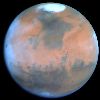 HST Image of Mars | Mars - 4 minutes away on average. This picture, taken by the Hubble Space Telescope is a true color image showing the polar ice cap. A meteorite that originated from Mars and landed in Antarctica shows evidence for Life on Mars which may have existed over 3 billion years ago according to some NASA scientists. Scientists at UCSD's Scripps Institution of Oceanography dispute the claim of Martian life, however. Mars is considered the most hospitable place for life after the earth. For more info about Mars see Mars Introduction by Calvin Hamilton or Mars View by Bill Arnett. |
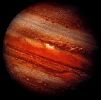 |
Jupiter is about 30 light minutes from the Sun (hence about 20--40 light-minutes from Earth depending upon the relative locations in orbit. Jupiter's Great Red Spot is a gigantic storm in the upper atmosphere. At right, Io , with its huge volcano erupting fumes of sulfur. For more info about Jupiter see Jupiter Introduction, or Jupiter View, or Jupiter APODs. |
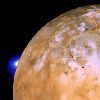
Loki Volcano on Io |
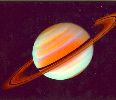 |
Saturn with its fantastic rings is about 1 light hour from the Sun. These are "false color" image from Voyager. Saturn's large satellite Titan is massive enough to have its own atmosphere, though probably too cold to support life. For more info see Saturn Introduction, or Saturn View, or Saturn APODs. |
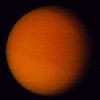 |
| Neptune - 4 hours away, is, until March 1999, the outermost planet in the Solar System due to Pluto's highly elongated orbit. Because Neptune receives less than one tenth of one percent of the sunlight that we receive on earth, astronomers had expected Neptune to be cold and dormant. Instead, Voyager 2 showed Neptune to have activity much like Jupiter, including the giant dark storm system shown here. For more info see Neptune Introduction, or Neptune View, or Neptune APODs. |
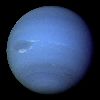 Voyager at Neptune |
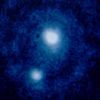 |
Pluto and its companion (satellite) Charon. Pluto is the smallest of the planets and has been considered for demotion to a minor solar system body. It is also the planet with the most eccentric orbit; it lies at an angle to the rest of the ecliptic. From about 1979 to 1999 Pluto was within Neptune's orbit, making Neptune temporarily the most distant planet from the sun. For more info see Pluto Introduction or Pluto View. |
| Continuing our journey outward for nearly one year , we come to the Oort Cloud which may contain as many as a trillion comets. Comets are of particular interest to astronomers because they may be the most primitive objects in the Solar System, revealing much about the conditions when our Solar System formed. Recent comets include Comet Hale-Bopp Bright ice/rock nucleus,yellow dust tail and faint blue gas tail. Comet Halley A short-period comet, Halley passes near the Earth every 76 years. First mentioned in the historical record in 240BCE, it can also be seen in the Bayeux Tapestry which commemorates the Battle of Hastings in 1066 (look in the upper left hand corner). Named after Edmund Halley who calculated its orbit in 1705 and predicted the date of its next appearance. | 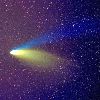 Comet Hale-Bopp |
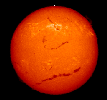 |
Looking back at the Sun, our star - 8 light-minutes = 1.5x1013 cm = 150 million km = 93 million miles from Earth. The Sun is a very middle class star, unique only becuse of its proximity and importance to Earth. |
The next nearest star is Alpha Centauri, a triple-star system visible from the southern hemisphere, four light-years away. As a measure of how empty space is, consider a model in which the Sun is represented by a large grapefruit; the Earth would be the size of a fancy pinhead ten paces away and the next grapefruit (Alpha Cen) would be in Cleveland! (n.b. a light year is a distance not a time. One light-year (l.y.) is the distance that light waves travel in a year = 1.0 x 1018cm, about 6 trillion miles.)
Before we get too cavalier about zipping around the Solar System at light speed lets remember how far beyond our current capabilities this is:
| Solar System Travel | ||||
|---|---|---|---|---|
| Speed | Time to Jupiter | Time to Saturn | Time to
 Cen Cen | |
| Freeway Speed | 75 mph | 600 yrs | 1200 yrs | 38 million yrs |
| Jetliner Speed | 500 mph | 90 yrs | 180 yrs | 6 million yrs |
| Concorde Speed (Mach 2) | 1350 mph | 33 yrs | 66 yrs | 2 million yrs |
| Spacecraft Speed (Voyager) | 40,000 mph | 1.5 yrs | 3 yrs | 70,000* yrs |
The
Voyager
Spacecraft, the most sophisticared space missions yet attempted by humans,
took years to get to Jupiter & Saturn. As of 1999 May, Voyager 1 was
nearly 6 billion miles from earth; it takes over 20 hours to send a signal
and receive a reply. See where
Voyager is now. *The Voyager Spacecraft are not headed
toward  Cen, by the way.
Cen, by the way.
| The Pleiades Star Cluster, The Seven Sisters of Greek Mythology (Suburu to the Japanese) 375 l.y. away, is a relatively young cluster of hundreds of stars with an age of about 75 million years. Most stars form in clusters like the Pleiades. |
 |
 | The Orion Nebula - 1500 light years, visible as the second "star" in Orion's sword. This gaseous nebula contains a younger cluster of stars (age ~ 1 million years). The hot young stars in the Trapezium near the center are ionizing and heating the surrounding gas, causing it to fluoresce. Compare the above with a much longer exposure of Orion, showing the faint outer regions. The nebula sits on one edge of a cold, relatively dense molecular cloud, wher star formation is occurring actively. |
| The Crab Nebula, about 6000 l.y. away in the direction of Taurus, is the remnant of a massive star that ended its life in a gigantic supernova explosion in July 1054. The glowing gas in the picture is the "star stuff" enriched in heavier elements (C,O,S, etc) produced in the nuclear fusion furnace at the star's core. At the center of the Crab Nebula is a pulsar --- a rapidly rotating, highly magnetized neutron star. The supernova was noted by Chinese astronomers and is also commemorated in Asasazi Petroglyphs in Chaco Canyon and other southwestern Native American sites. Curiously there is no mention in European records. Another look at the Crab from the Web Nebulae. |
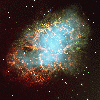 |
 |
The Veil Nebula part of the Cygnus Loop, remnant of a supernova that occurred about 15--20 thousand years ago. As the explosive shock wave moves outward from the dead star, it plows up material from the interstellar medium, causing it to glow. The gas in the center is heated to temperatures of millions of degrees and is a strong source of x-rays. |
| The Ring Nebula , about 5000 l.y. in the constellation Lyra, is the final death "hiccup" of a star like our Sun. The outer layers of the star are ejected as it runs out of nuclear fuel and the hot inner core causes the ejected gas to fluoresce. This final stage is called a Planetary Nebula, though it has nothing to do with planets. At the center of the planetary nebula is the small (R~Rearth) intensely hot (T~100,000K) cinder of the dying star - a white dwarf. |
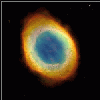 |
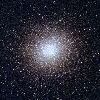 | Globular Cluster -- Globular clusters are gravitationally bound clusters of millions of stars, formed in the very early history of our galaxy, 10--15 billion years ago. There are about 250 globular clusters distributed roughly spherically around the Milky Way. Take a tour of the Milky Way's globular clusters. Some other galaxies have many thousands of globular clusters. |
| Our Milky Way galaxy is a system of nearly a half a trillion stars. It is 100,000 l.y. across. The Sun is about 2/3 of the way toward the outer part of the galaxy disk. | 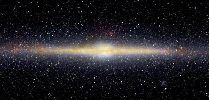 The Milky Way in the Infrared |
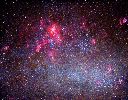 | The Large Magellanic Cloud with The Small Magellanic Cloud are satellite galaxies to the Milky Way.They lie about 150,000 l.y. away in the southern skies. The Magellanic clouds were first described to Europeans by the crew of Magellan's ships as they rounded the tip of Cape Horn. Part of the collection of galaxies known as the "Local Group". |
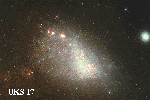 |
| The Andromeda Galaxy - 2 million light years. This galaxy and our Milky Way make up the dominant galaxies of our local cluster, "The Local Group". The Andromeda Galaxy, also known as Messier 31, is somewhat more massive than the Milky Way, but otherwise structurally similar. |
|
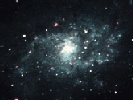 |
Spiral Galaxy Messier 33 (M33) Another member of the Local Group of galaxies. With the Milky Way and Andromeda, the only three spiral galaxies in the Local Group. |
| The Local Group of Galaxies is our own small cluster of about 30 galaxies, dominated by the Milky Way and Andromeda. For more info . |
 |
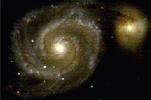 |
M51 The Whirlpool Galaxy, located about 15 million light-years from Earth, is undergoing a tidal interaction with its companion SB galaxy. The beautiful spiral structure in M51 may be due to this gravitational interaction. |
 |
The Virgo Cluster
of Galaxies (left) is the closest galaxy cluster to the Milky Way, about
50 million l.y. away. Virgo contains several hundred galaxies. Our local
group is an outlying satellite of the Virgo Cluster The Hercules Cluster of galaxies (right) 650 million light-years from Earth is unusual in the number of spiral galaxies that it contains. |
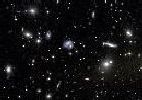 |
| Quasar 3C273 -- Quasars are the most luminous objects in the universe, visible to distances of billions of light years. They are believed to be powered by a massive central black hole, perhaps 100 million to a billion times the mass of the Sun. It generates energy by accreting nearby matter. 3C 273 was one of the first quasars discovered; with a redshift that corresponds to 15% of the speed of light , z = 15%, it is about two billion l.y. away. It is orders of magnitude brighter than the faint galaxies in a small group around the quasar, just visible in this photograph. |
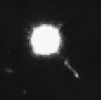 |
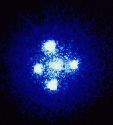 | Gravitational Lens A very massive object, such as this cluster of galaxies, can act as a gravitational lens. Light passing through the cluster from an object located behind it can be focused and amplified to produce one or more images of the background object. The four bright spots in the forground are lensed images of a spiral galaxy lying behind the cluster. |
| The Hubble Deep Field, the deepest space photograph taken to date shows galaxies billions of light years away, as they were when the Universe was only a fraction of its current age, believed to be 10--20 billion years. |
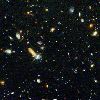 |

![]() History
History
![]() Scale of the Universe
Scale of the Universe
![]() Education & Outreach
Education & Outreach
![]() CASS Home
CASS Home